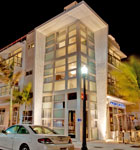1. Identify a need
An antique, 18-stall roundhouse isn’t constructed on a whim. After their heyday in the late 19th and early 20th centuries, few have been built since 1950 because of the dwindling supply of steam engines. For Jacobson, though, there were none capable or close enough to handle his collection of more than a dozen steam locomotives, 25 diesels, and several dozen passenger and special-use cars.
“It’s an extensive fleet,” says Bob Brode, co-owner of the WM Brode Company, the contractor that spearheaded the construction. “Some people have a garage for their Corvettes; this is Jerry’s garage for his locomotives.”
2. Pick the right people
Perhaps no men in America were more qualified to build a period roundhouse than the group Jacobson selected. Brode had a lifetime of experience working on railroad infrastructure and bridges. Jeff Orr, with Amish Timber Framers Inc., had access to both the manpower and the historical technology for a true recreation. And, after years of historical renovations with FA Goodman Architects, Frederic Goodman was well equipped to tackle a historical construction such as the roundhouse.
“We’re all a bit long of tooth,” Orr says, referring to their ages. “It was a group of guys that came together and pooled their talent over a lifetime.” Lang Masonry Contractors Inc. and Zemba Bros., Inc. also were essential contributors to the site work and brickwork.
 3. Find a turntable
3. Find a turntable
Because an old steam locomotive only points and moves in one direction, there must be a way to rotate the engine, not only to turn it around on the track but to align it with its stall in the roundhouse. Luckily, the team found a 115-foot vintage turntable in western Maryland—along with the original blueprints.
Once a turning mechanism is found, there’s the issue of the drop pit, which was used as a maintenance area in older roundhouses before jacks were widely available. The Age of Steam pit features two drop tables: a shorter one for steam locomotive drive wheels and a much larger one to handle the diesels’ three-axle wheel sets. Both tables share a common release track, which the builders believe to be the only such steam-diesel arrangement in the world.
 4. Complete the timber framing
4. Complete the timber framing
Despite just an eighth-grade education, Amish workers produce some of the most elegant timberwork in the business. When Brode measured the finished framing with laser transits, he found that the dimensions varied only a quarter of an inch from the plans. With mortise-and-tenon joints and more than a mile of 15-inch wooden pegs, the framing is true to the era. “It was a talented labor force,” Orr says. “We basically brought early 19th-century technology to a modern construction site.”
5. Comply with safety standards
Modern regulations are the wrench thrown into the gears of a historical recreation. The roundhouse might have an aged appearance on the outside, but the inside was kept to code with sprinklers, concrete masonry, Thermopane windows, and new lightbulbs in vintage fixtures.
 6. Craft a state-of-the-art repair facility
6. Craft a state-of-the-art repair facility
“It was literally like fitting a round peg in a square hole,” Brode says, noting that the right angles of the back shop building needed to be connected to the roundhouse. Clad in red brick from the Belden Brick Company, the back shop has every appearance of a structure from the late 1920s. It was built simultaneously with the roundhouse and is identical outside but modern on the inside, complete with all the necessary maintenance tools.
 7. Add the finishing touches
7. Add the finishing touches
There was no public source of water, so the builders constructed an all-wood water reservoir and a septic system. A 70-foot-tall coaling station is also under construction; they hope to complete it in 2012.
8. Marvel at the beauty of an obsolete vehicle
“The real thrill is pulling the throttle,” says John B. Corns, the director of acquisitions and asset management at the roundhouse. “It sucks your breath away.”
Railroads helped us reach the frontier. They took the country to war. They kept the country alive. The Saturday after 9/11, Corns remembers firing up Jacobson’s biggest steam locomotive and seeing thousands lining the tracks with flags waving and tears on their cheeks. “Everyone is very proud of the heritage,” Corns says. “This roundhouse is going to be around for a long time.” ABQ

 3. Find a turntable
3. Find a turntable 4. Complete the timber framing
4. Complete the timber framing 6. Craft a state-of-the-art repair facility
6. Craft a state-of-the-art repair facility 7. Add the finishing touches
7. Add the finishing touches

